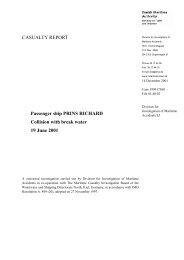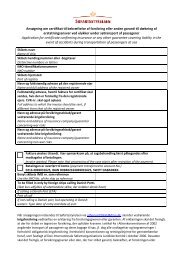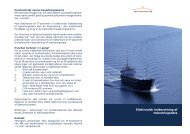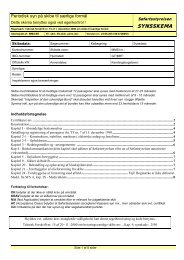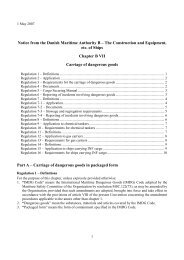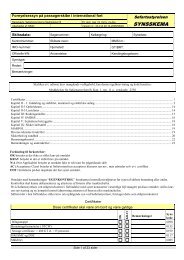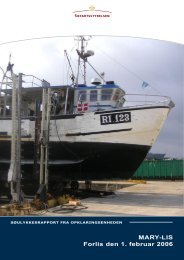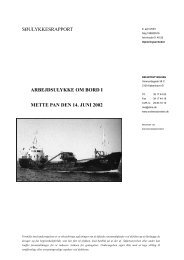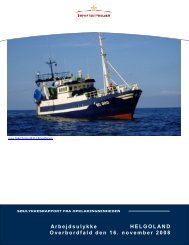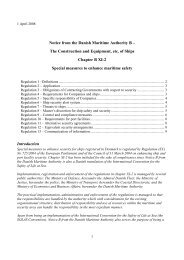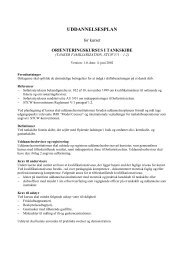kvartalsvis orientering 1 2009 - Søfartsstyrelsen
kvartalsvis orientering 1 2009 - Søfartsstyrelsen
kvartalsvis orientering 1 2009 - Søfartsstyrelsen
You also want an ePaper? Increase the reach of your titles
YUMPU automatically turns print PDFs into web optimized ePapers that Google loves.
Kvartalsvis Orientering 1/<strong>2009</strong>Quaterly Information 1/<strong>2009</strong>Loading of 716mt of iron bundles was finished at 1220 and the vessel departed withoutpilot on board at 1240 bound for Randers. BLUE BIRD passed the approach buoy toRanders Fjord at 1927, but did not embark a pilot. During the inbound transit in thedredged channel, the master and chief officer were on the bridge. The master wassteering the vessel using manual hand steering and the chief officer was assisting.HAGLAND BONA departed from Kragerø in Norway 30 November 2008 at 1245 andarrived to Randers 1 December at 0930. Discharging started at 0945 and was completedat 1850. The vessel departed from Randers at 1910 without pilot on boardbound for Herre (Norway) to load timber / logs. From departure until the time of thecollision the master was alone on the bridge.When HAGLAND BONA departed from Randers, the master announced the departureon VHF channels 16 and 12. From a pilot on an outward bound vessel at the entranceto Randers Fjord, HAGLAND BONA was informed of the expected arrival of BLUEBIRD. HAGLAND BONA contacted BLUE BIRD on VHF channel 12, and it becameclear that HAGLAND BONA could not clear the channel before BLUE BIRD had enteredthe channel. The master of HAGLAND BONA therefore recommended that thetwo vessels passed each other port to port at a position due east of Støvringgaard ISOWG.2s 4m (Approximate position of this meeting point is 56° 30’28N / 010° 13’77E –see figure 1). The master of BLUE BIRD agreed to the suggested way of passing andthe passing point.As BLUE BIRD passed Skalmstrup Vig the speed was reduced to below 6 knots as perlocal rules. When approaching the agreed passing point, the master of BLUE BIRDpositioned the vessel as far to starboard in the channel as possible, preparing to passthe other vessel port to port. According to the master of BLUE BIRD he in fact at timeswas out of the channel on its starboard side. When BLUE BIRD was approximately 0.2nm north of the passing point, the vessel was on the western edge of the dredgedchannel.Approximately 15 minutes before the collision, when HAGLAND BONA approached thepassing point from the south, the master of HAGLAND BONA observed that BLUEBIRD would enter the narrow stretch before HAGLAND BONA could clear this narrowpart. The master therefore called BLUE BIRD on VHF requesting this vessel to reducespeed. The master of BLUE BIRD agreed, but HAGLAND BONA did not observe anyreduction in BLUE BIRDs speed. HAGLAND BONA therefore increased his speed inorder to clear the narrow stretch before BLUE BIRD entered. After HAGLAND BONAsincrease in speed, the master of BLUE BIRD plotted HAGLAND BONAs speed to 8.9knots.According to a log-printer on board HAGLAND BONA showing date, time, and ownvessels position, course and speed, the speed at 2036 was 4.4 knots. At 2040 and at2045 the speed was 7.3 knots.According to the master of BLUE BIRD, at 2037 – 12 minutes before collision –he reducedthe speed to 3.2 knots / 320 rpm in order to let HAGLAND BONA clear the narrowpart of the dredged channel.According to AIS-data from the Danish Maritime Safety Administration, at 2046 BLUEBIRDs speed was 5.3 knots.28



